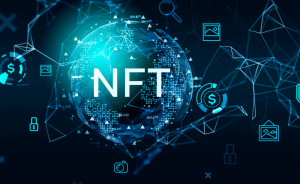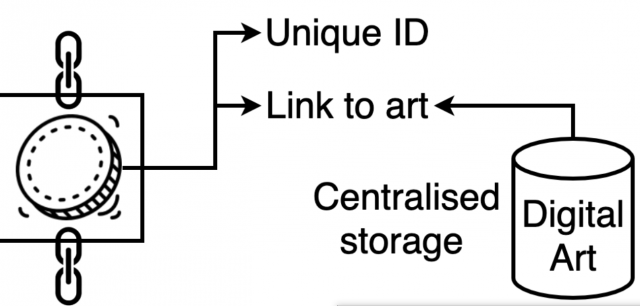
You may have heard the term “non-fungible tokens (NFT)” but what do they mean? Basically, they are a type of cryptocurrency that is unique and not interchangeable. Unlike regular Bitcoin or Ethereum, which can be divided and traded like shares, non-fungible tokens are indivisible and have their own value. This makes them perfect for use in specific applications like digital art or collectibles. Here we’ll discuss what are NFTs and what are some real-world examples of where non-fungible tokens are being used today.
What are Non-fungible tokens (NFT) and how do they work?
Non-fungible tokens are unique digital assets. The word non-fungible means that each token is not interchangeable with another token. This is in contrast to cryptocurrencies like Bitcoin, which are fungible tokens, meaning each Bitcoin is the same as any other Bitcoin. Non-fungible tokens have the potential to change the way we interact with digital assets and could potentially revolutionize the way we trade and use these assets in the future.
NFTs are used to represent digital assets that are unique and cannot be replaced. Some common examples of NFTs include digital game items, collectible art pieces, or virtual real estate. Non-fungible tokens are stored on a blockchain, similar to how cryptocurrency transactions are recorded on a blockchain. The key difference is that NFTs store information about the asset itself on the blockchain rather than just storing details of the transaction. The diagram below represents how an NFT representing digital art is stored on the blockchain with a unique ID and a link to access the digital art which is stored in off-chain storage. The NFTs can be said to be anchored on the blockchain network with the ability to access the actual asset from the centralized storage which is also termed the off-chain storage.
One of the key features of NFTs is their ability to be traded on decentralized platforms like blockchain networks. This allows users to buy, sell, transfer, or trade these digital assets just as they would with traditional assets like stocks and bonds.
One of the benefits of NFTs is that they can’t be counterfeited like traditional physical assets. Because each NFT is stored on a blockchain and assigned a unique identifier it is impossible to create a duplicate. Another key benefit of NFTs is that they can be divided into fractional units. This means that you can own a small portion of an NFT, unlike traditional assets which are either all or nothing. For example, you could own 1/100th of a virtual piece of art or 1/1000th of a virtual world.
What are some real-world examples of Non-fungible tokens?
The following is the list of some real-world examples of Non-fungible tokens:
- CryptoKitties: Cryptokitties is a popular online game that uses Non-fungible tokens to represent digital cats. Each individual cat has its own unique traits and characteristics, making them highly sought after by players. Gamers would need to spend Ethereum to buy these NFTs and then use them within the game.
- Collectibles: Non-fungible tokens are also used to create digital collectibles, such as baseball cards or trading cards. These items can be transferred between users or sold for a profit, and there is often a secondary market where individuals can buy and sell these NFTs in exchange for other cryptocurrencies or fiat currencies. Some of the markets that have emerged for trading NFTs include OpenSea and RareBits.
- Decentraland: Decentraland is another popular example of Non-fungible tokens being used to represent the virtual real estate. Users can purchase LAND parcels on this platform using Ethereum-based NFTs, and then they can develop or use these properties as they see fit. In case you are interested in purchasing these NFTs, you can do so from the Decentraland Marketplace.
- Godot Engine platform: Non-fungible tokens are also being used to create and sell digital game assets on the Godot Engine platform. Developers can list their NFTs for sale, and gamers can purchase these items and then use them in the games they play.
- ENS domains: Ethereum Name Service domains can be purchased using Non-fungible tokens, and these can be used to represent a variety of different cryptocurrency addresses.
- WAX tokens: Non-fungible tokens are also being used as a digital representation of real-world assets on the WAX platform. In this case, individual users can purchase and trade NFTs that represent collectibles or other items they own in the physical world.
How to buy and store NFTs?
Now that we have understood what is NFTs, the next thing is to get an understanding of how to buy and store them.
One of the most popular ways to buy NFTs is through crypto exchanges that support these tokens. Some well-known examples include Binance and Bitfinex, both of which allow you to easily purchase NFTs with the cryptocurrency of your choice.
Once you have purchased an NFT, it’s important to keep it safe by securely storing your private key or seed phrase. Options for doing so include using a hardware wallet such as Trezor, or downloading a software wallet like MetaMask or MyEtherWallet. Whichever option you choose, be sure to take the necessary precautions to ensure that your assets are protected from theft or loss.
Whether you’re looking to invest in NFTs for the long-term or simply want to try out some of the newest blockchain games, it’s clear that NFTs are here to stay. With their unique features and increasing popularity, they are an important asset class to be aware of in today’s rapidly evolving cryptocurrency landscape.
How to develop NFT based application?
If you are a software engineer, you may be interested in knowing the technologies that you need to learn in order to create NFT-based applications. Non-fungible tokens, or NFTs, are digital assets that are unique and cannot be replicated, making them ideal for a wide range of uses in the world of technology.
One possible application for these tokens is in gaming. There has been a recent surge in popularity of blockchain-based games that utilize NFTs, such as CryptoKitties. These games allow players to purchase and trade unique virtual characters or items, which can then be used in the game itself or sold to other players for profit.
Another potential use for NFTs is in the art world. Many artists have begun experimenting with using blockchain technologies to create and distribute their artwork digitally. By using an NFT, an artist can ensure that their work is truly unique and can not be replicated or counterfeited. Additionally, NFTs can also be used to track the provenance of a piece of art, making it easier to determine its authenticity.
There are many other potential applications for NFTs, such as in the music industry, real estate, and even identity verification. As the technology continues to develop, it is likely that we will see even more innovative uses for NFTs in the future.
If you’re looking to get started in developing NFT-based applications, there are a few key technologies that you’ll need to learn.
- First and foremost, you’ll need to be proficient in a blockchain platform like Ethereum or EOS. These platforms provide the infrastructure that is necessary to create and manage NFTs.
- In addition, you’ll need to be familiar with smart contracts. Smart contracts are bits of code that live on the blockchain and govern the behavior of NFTs. They are used to track ownership, enforce rules, and facilitate transactions.
- Finally, you’ll need to have a good understanding of front-end development technologies like HTML, CSS, and JavaScript. This will allow you to create user-friendly interfaces for your applications.
With the above technologies under your belt, you’ll be well on your way to developing the next great NFT-based application.
The future of NFTs?
It is also important to learn about how does the future of NFTs looks like. Non-fungible tokens are becoming increasingly popular and widely used in various industries, such as gaming, real estate, finance, art, and more. As the technology continues to evolve and improve, it is likely that we will see even greater adoption and utilization of NFTs in all sorts of different scenarios.
One example of an industry that has been leveraging the power of NFTs is gaming. Many games today are using NFTs as a way to represent digital assets within their virtual worlds. These game assets can range from simple collectibles like pets or avatars, to more complex items like weapons or rare items. By allowing users to own these digital assets via NFTs, developers are able to create unique incentives for users to play and engage with their games.
In the future, we will likely see even more industries adopt NFTs as a way to represent ownership of digital assets. For example, the real estate industry could use NFTs to tokenize property ownership. This would allow for fractional ownership of expensive properties, as well as a more efficient and secure way to transfer ownership. The possibilities are endless and it will be exciting to see how non-fungible tokens continue to shape our world.
- Coefficient of Variation in Regression Modelling: Example - November 9, 2025
- Chunking Strategies for RAG with Examples - November 2, 2025
- RAG Pipeline: 6 Steps for Creating Naive RAG App - November 1, 2025

I found it very helpful. However the differences are not too understandable for me